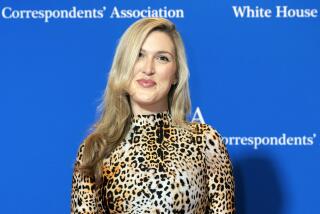Media Group Assails ‘Nightline’ for Being Too Narrow : Koppel, Producer Challenge Report, Say Show Is a News Program, Not Equal-Access Forum
- Share via
A stinging report attacking ABC’s “Nightline” for its “narrow range of guests and limited scope of issues” is being released in New York today by the media-watchdog group Fairness and Accuracy in Reporting (FAIR).
The 45-page report--”Are You on the ‘Nightline’ Guest List? An Analysis of 40 Months of ‘Nightline’ Programming”--concludes that the chances of appearing on Ted Koppel’s program are substantially enhanced “by being a white, male member of the government, military or corporate Establishment.”
The report, prepared by William Hoynes and David Croteau of the sociology department at Boston College, analyzed 865 “Nightline” programs and 2,498 guests from Jan. 1, 1985, through April 30, 1988. Among a host of findings was that 89% of total American guests on the program were men, and that 92% were white.
At the other end of the spectrum, the report found that viewpoints espoused by representatives of the peace movement, consumer rights advocates, labor leaders and racial/ethnic leaders were hardly seen or heard. Altogether, public-interest advocates represented 6.2% of the occupations of “Nightline’s” guests.
“ ‘Nightline’s’ guest list represents a profoundly elitist perspective of both domestic and foreign societies. . . ,” the report stated. “Overwhelmingly it is white, male representatives of powerful institutions who interpret the world for ‘Nightline’s’ viewers. Essentially absent from the guest list are representatives of civic and community organizations, popular social movements, minority communities. . . .
“The narrow range of guests,” the report added, “makes ‘Nightline’ a fundamentally conservative political program.”
Unlike conservative media-watchdog groups (such as Reid Irvine’s Accuracy in Media), Fairness and Accuracy in Reporting (founded in 1986), defines itself as a “progressive media-reform” organization.
“Nightline” was chosen for examination, the report said, because the program is watched by 5 million to 7 million American households on an average weeknight and is “one of the leading sources of news information in the United States. With its combination of near-universal acclaim from critics . . . ‘Nightline’ is an important player in defining the national political terrain.”
There were immediate responses from both Koppel and “Nightline’s” executive producer, Richard Kaplan, who challenged the premise of the report, saying “Nightline” is a news program rather than an equal-access forum.
Ironically, the FAIR report itself pointed out that “Nightline,” which went on the air on March 20, 1980, in the midst of the Iran hostage crisis, has garnered two dozen Emmys for its news coverage in nearly nine years on TV.
The report also concluded that:
--Henry Kissinger and Alexander Haig, both former secretaries of state, lead the list of “Nightline” guests with 14 appearances each.
--Of the 19 guests who appeared more than five times, all but two, including Jesse Jackson, are not white, and in that cluster there were no women.
--Twelve persons appeared as a solo guest more than once, including former President Jimmy Carter and Philippines President Corazon Aquino, leading with three appearances each.
--On programs about international issues, 94% of the guests were men, while women were most visible on programs about social issues. Even on social issues, however, only 19% of the guests were women. “On shows about Central America, there was not one woman guest,” the report said. “This is largely a reflection of ‘Nightline’s’ lack of attention to the U.S. movement against intervention in Central America, which has many women in significant leadership roles,” the report said.
--Women speak less than men on “Nightline”--43 vs. 50 transcript lines on average.
FAIR’s report appeared to offer certain disclaimers to its findings: It explained that “ ‘Nightline’ doesn’t systematically exclude women and minorities solely because of their race and gender”; rather, they are underused “because women and minorities are disproportionately underrepresented in the class from which ‘Nightline’ draws most of its guests.”
At the same time, the report also explained that “we only studied those guests that appeared on the show itself, not those appearing in prepared video reports.” These, the authors conceded, “play a role in the framing process by setting the issue or event in a context,” and they suggested “further research” in that area.
Kaplan said these “focus” reports at the beginning of a show occur in more than one out of four programs.
Koppel asserted Friday that while “there are a couple of legitimate criticisms” involving program content--including looking at issues of terrorism “much too narrowly” and not doing “as many program as we ought (to) on state terrorism,” such as the death squads in El Salvador--Fairness and Accuracy in Reporting is “missing the larger point. Ours is a news program. It is not meant to be a forum to give all divergent views in the United States equal access.
“When we are covering the news, we try to go to the people involved in the news,” Koppel continued. “What they have reflected in their analysis of our guest list is that over the 40 months, we’ve been dealing with a rather conservative Reagan Administration. If we had a liberal administration in office, you would suddenly see an enormous disparity in the other direction.”
Turning to criticisms of who appears as a guest alone, such as arms dealer Richard Secord (twice) while consumer advocate Ralph Nader never did, Koppel asserted that that “totally ignores what is said on that program.” When Secord appeared by himself, “We were in the middle of the Iran-Contra hearings. Everyone wanted to talk to Richard Secord but not to give him an opportunity to ask his views, but to ask a lot of tough questions.”
Kaplan, noting that “Nightline” is a “news program, not the Op-Ed page of a newspaper,” pointed out that “Nightline” tries “to get the players, the people who really are the decision makers, to hold their feet to the fire.”
Ridiculing those who “count lines in a transcript,” Kaplan noted that “Nightline” is more “complex” than trying to place guests and subject matter into boxes of “Xs and Os, Ones and Twos.”
“I like studies like this,” Koppel said. “I’m happy to see them, whether they are from the right or the left. They do give us an opportunity to re-examine what we do, how we do it. And sometimes it’s quite true we get into a rut. . . .”
More to Read
The complete guide to home viewing
Get Screen Gab for everything about the TV shows and streaming movies everyone’s talking about.
You may occasionally receive promotional content from the Los Angeles Times.






